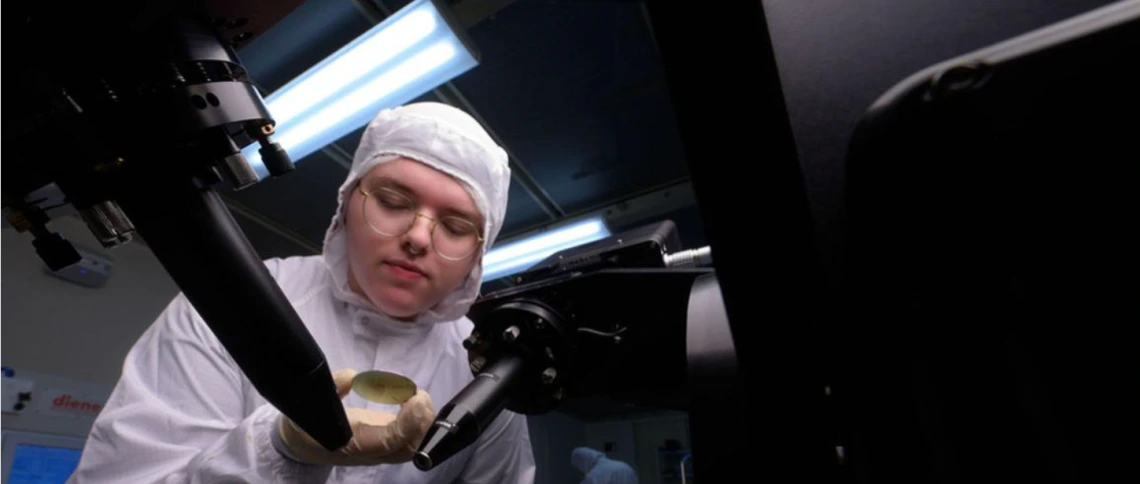Educating a State and National Semiconductor Workforce

Graduate student Katie Martin works in the university’s Nano Fabrication Center, which is being renovated and expanded thanks to an investment from the Arizona Commerce Authority. The facility supports manufacturing and research efforts involving semiconductors, computer chips, optical devices and quantum computing systems.
A popular summer camp is the latest in a series of collaborations and initiatives designed to increase semiconductor career training access.
The semiconductor-focused Chips and Wafers Camp opened for registration with 40 slots available to Chandler, Arizona, high school students between their freshman and sophomore years.
“Stop, stop!” Liesl Folks, the University of Arizona vice president of semiconductor strategy, was soon saying, as reported in an East Valley Tribune article(link is external). “We got 96 applicants in about the first 36 hours.”
Chips and Wafers is a partnership between the UA, Chandler Unified School District and several private companies. This team came together to train students to fill the labor shortage of specialists who work with semiconductors, building blocks of the computer chips that control everything from cellphones to satellites.
The camp is a precursor to a two-year career and technical education course that will begin at Chandler’s Hamilton High School in fall 2025 in cooperation with the East Valley Institute of Technology.
Students spent much of the June camp touring Chandler semiconductor businesses.
“Nothing inspires students as much as being able to actually talk to people who work in the field, see the cool equipment, and do hands-on experiments,” said Folks, director of the university’s Center for Semiconductor Manufacturing(link is external) and professor of electrical and computer engineering(link is external). “Kids have to see it. And they have to meet people in the field, and hear about their careers, in order to make a decision that this is what they want to do.”
A Bridge to Jobs
The Chandler programs are part of a series of collaborations and initiatives the university and the College of Engineering(link is external) have fostered to meet national and state needs for semiconductor workers and contribute to Arizona’s status as a burgeoning global semiconductor manufacturing powerhouse.
Since 2020, the state has attracted more than 35 semiconductor expansions, representing 13,000 potential jobs, according to the Arizona Commerce Authority. Arizona has also drawn the most investment from the 2022 CHIPS and Science Act’s $53 billion to date.
The UA is opening up opportunities on and off campus, further establishing itself as a key connector between educational programs and these high-paying jobs.
“The University of Arizona and the College of Engineering will continue to play a major role in the strides the state is making in the global semiconductor industry,” said David W. Hahn, the Craig M. Berge Dean of the college. “We’re committed to making the investments and forging the workforce partnerships.”
Wide-Ranging Collaborations
Because the industry demands workers from the technician level to positions requiring doctoral degrees, the university is taking a comprehensive approach to educational partnerships.
Within Arizona, the university formalized an agreement with Northern Arizona University to ensure close collaboration on research and academic programs. And an array of augmented-reality training modules – jointly developed with academic partner institutions Pima Community College and Central Arizona College – will soon bring nanotechnology and semiconductors to life for students all over the state.
“We’re very excited about the opportunity to reduce the barriers to access for students everywhere in Arizona to get involved in the semiconductor sector,” said Folks.
While the Hamilton High School course is the first of its kind in the U.S., collaborators intend to expand the model nationally.
“Ultimately, we plan to build and share curriculum and learning modules to educational institutions at all stages, and we’ll provide training to help teachers feel confident in delivering the material,” said Folks.
UA Programs and Facilities
The UA campus will also offer increased access to semiconductor career training. Engineering is partnering with the colleges of science and optical sciences to launch several new university semiconductor programs in the 2024-2025 academic year. These include a minor in semiconductor manufacturing, plus three stackable graduate certificates and an accelerated master’s program in semiconductor science and technology.
Facility upgrades are in the works as well. The university is building the Future Advanced Semiconductor Technology Laboratory (FASTLab) to offer hands-on experiences with semiconductor nanotechnology for students in high school through graduate school. And in spring 2024, the university launched a major renovation and expansion of the Nano Fabrication Center, increasing research and development capacity and creating a state-of-the-art training facility for students aiming to work on the next generation of semiconductor technology. The ACA awarded the college $35.5 million for the improvements and associated programs.
"We're proud to support the University of Arizona with the expansion of this state-of-the-art center, which will serve as a key resource to drive further workforce development and innovation throughout Arizona,” said ACA President and CEO Sandra Watson.
